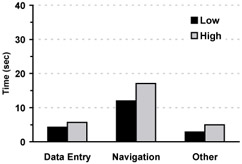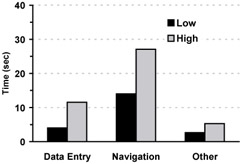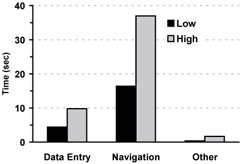Results
|
| < Day Day Up > |
|
One hundred seventy-five participants took part in this study. Data for four participants were incomplete due to the participant becoming ill and leaving early (2), hardware problems (1), or failure to follow instructions that made data analysis impossible (e.g., completing tasks multiple times) (1). The remaining 171 participants completed a total of 546 tasks. Of these, results for 23 individual tasks were lost because the resulting documents could not be retrieved; leaving 523 tasks that could be analyzed. Table 3 indicates how these 523 tasks were distributed by platform, task difficulty, and application. Outliers, based upon task completion times or error rates, were identified using boxplots and removed prior to analysis. Outliers were defined as values that fell below the lower outer fence (less than Lower Hinge - 3 *Hspread) or above the upper outer fence (more than Upper Hinge + 3*HSpread). The central 50% of the values fall between the upper and lower hinges while Hspread is equal to absolute value of the difference between the values of the two hinges (SPSS, 1999). A logarithmic transformation was applied to t, tD, tN, and tO prior to analysis.
| Platform | ||||
|---|---|---|---|---|
| Application | Task | 133 | 266 | 400 |
| Excel | Low | 30 (4) | 29 (3) | 29 (2) |
| High | 30 (0) | 30 (1) | 27 (7) | |
| PowerPoint | Low | 24 (3) | 30 (4) | 29 (7) |
| High | 30 (4) | 32 (1) | 29 (2) | |
| Word | Low | 26 (1) | 35 (3) | 25 (3) |
| High | 29 (1) | 30 (5) | 29 (4) | |
Total Task Completion Time
Table 4 reports the means and standard deviations for the total task completion time for the low- and high-demand tasks for all three applications. Separate two-way ANOVAs were used to assess the significance of platform and task on task completion times for each of the three applications. To facilitate the investigation of H4, post hoc comparisons were utilized to identify any differences between the 133 and 400 platforms when the low- and high-demand tasks were analyzed individually.
| Platform | ||||
|---|---|---|---|---|
| Application | Task | 133 | 266 | 400 |
| Excel | Low | 19.7 (6.0) | 18.4 (6.3) | 19.2 (7.6) |
| High | 31.5 (15.3) | 28.6 (12.6) | 21.0 (5.1) | |
| PowerPoint | Low | 18.7 (5.4) | 21.0 (6.8) | 22.4 (6.3) |
| High | 40.8 (16.1) | 45.3 (16.4) | 45.6 (14.8) | |
| Word | Low | 20.2 (5.8) | 21.6 (5.6) | 22.2 (5.9) |
| High | 49.4 (16.9) | 48.1 (8.9) | 48.0 (11.3) | |
For Excel, a significant main effect was identified for task (F(1,152)=26.9, p<0.001), but not for platform (F(2,152)=3.0, n.s.). The interaction between task and platform was not significant (F(2,152)=2.2, n.s.). Post hoc comparisons identified significant differences between the 133 and 400 platforms for the high-demand task (F(1,152)=8.8, p<0.01).
For PowerPoint, a significant main effect was identified for task (F(1,147)=28.7, p<0.001), but not for platform (F(2,147)=2.8, n.s.). The interaction between task and platform was not significant (F(2,147)=0.1, n.s.). Post hoc comparisons did not identify any significant differences between the 133 and 400 platforms when the high- and low-demand tasks were analyzed individually.
Results were similar for Word where a significant main effect was identified for task (F(1,151)=370.7, p<0.001), but not for platform (F(2,151)=0.6, n.s.). The interaction between task and platform was not significant (F(2,151)=0.5, n.s.). Again, post hoc comparisons did not identify any significant differences between the platforms when the high- and low-demand tasks were analyzed individually.
Overall, high-demand tasks resulted in significantly longer task completion times than low-demand tasks for all three applications (see Figure 1). For Excel, the 400 platform resulted in significantly shorter task completion times as compared to the 133 platform (see Figure 2).

Figure 1: High-Demand Tasks Required Significantly More Time than Low-Demand Tasks for All Three Applications

Figure 2: Total Task Completion Time for the High-Demand Excel Task (400 Platform resulted in significantly shorter task completion times)
Error Rates
Table 5 reports the means and standard deviations for error rates for the low- and high-demand tasks for all three applications. Separate two-way ANOVAs were used to assess the significance of platform and task on task completion times for each of the three applications. For Excel, a significant main effect was identified for task (F(1,152)=75.7, p<0.001), but not for platform (F(2,152)=0.0, n.s.). The interaction between task and platform was not significant (F(2,152)=0.4, n.s.). To confirm that the significant differences identified in task completion times were not due to speed-accuracy tradeoffs, the post hoc comparisons conducted on task completion times were repeated on the error rate data. The post hoc comparisons did not identify any significant differences, confirming that the reduction in task completion times associated with the 400 platform was not associated with an increase in error rates.
| Platform | ||||
|---|---|---|---|---|
| Application | Task | 133 | 266 | 400 |
| Excel | Low | 0.09 (0.08) | 0.06 (0.06) | 0.09 (0.07) |
| High | 0.32 (0.22) | 0.33 (0.24) | 0.30 (0.23) | |
| PowerPoint | Low | 0.09 (0.11) | 0.05 (0.03) | 0.04 (0.02) |
| High | 0.13 (0.06) | 0.17 (0.08) | 0.19 (0.11) | |
| Word | Low | 0.06 (0.03) | 0.05 (0.03) | 0.05 (0.03) |
| High | 0.12 (0.10) | 0.09 (0.04) | 0.09 (0.04) | |
For PowerPoint, a significant main effect was identified for task (F(1,147)=69.5, p<0.001), but not for platform (F(2,147)=0.2, n.s.). The interaction between task and platform was significant (F(2,147)=5.9, p<0.01), so post hoc comparisons were conducted to provide greater insight into the potential importance of this interaction. For the low-demand task, the 400 platform resulted in significantly lower error rates than the 133 platform (F(1, 147)=4.1, p<0.05). In contrast, for the high-demand task, the 400 platform resulted in significantly higher error rates than the 133 platform (F(1,147)=7.0, p>0.01). No other significant differences were identified.
For Word, a significant main effect was identified for task (F(1, 151)=28.4, p<0.001) and platform (F(2,151)=3.4, p<0.05). The interaction between task and platform was not significant (F(2,151)=1.0, n.s.). Post hoc comparisons confirmed that the 133 platform resulted in significantly higher error rates than the 400 platform (F(1, 151)=4.5, p<0.05). Overall, high-demand tasks resulted in significantly higher error rates than low-demand tasks for all three applications (see Figure 3).

Figure 3: Error Rates for High- and Low-Demand Tasks for all Three Applications
Task Completion Time Subcomponents
To facilitate the evaluation of H3 and H4, additional analyses were performed on the three subcomponents of the task completion time: tD, tN, and tO. Tables 6, 7, and 8 report the means and standard deviations for tD, tN, and tO for the low- and high-demand tasks for all three applications. Separate two-way ANOVAs with repeated-measures were used to assess the significance of platform and task on the three components of the task completion times for Excel, Word, and PowerPoint.
| Platform | ||||
|---|---|---|---|---|
| Application | Task | 133 | 266 | 400 |
| Excel | Low | 4.0 (1.4) | 4.5 (2.3) | 4.3 (1.8) |
| High | 6.3 (4.2) | 5.7 (3.0) | 4.7 (1.8) | |
| PowerPoint | Low | 3.4 (1.1) | 3.9 (1.7) | 4.8 (3.6) |
| High | 9.9 (2.7) | 12.7 (5.4) | 12.0 (4.3) | |
| Word | Low | 4.2 (1.7) | 4.5 (1.6) | 4.6 (1.7) |
| High | 9.8 (3.2) | 10.2 (2.3) | 9.4 (3.8) | |
| Platform | ||||
|---|---|---|---|---|
| Application | Task | 133 | 266 | 400 |
| Excel | Low | 12.7 (5.2) | 11.0 (4.9) | 12.2 (6.4) |
| High | 19.8 (11.9) | 17.9 (9.9) | 11.9(4.0) | |
| PowerPoint | Low | 12.8 (4.2) | 14.5 (5.5) | 14.6 (3.4) |
| High | 25.9 (15.0) | 27.2 (13.2) | 28.2 (12.6) | |
| Word | Low | 15.5 (5.1) | 16.6 (4.9) | 17.2 (5.1) |
| High | 38.0 (15.5) | 35.5 (8.9) | 37.3 (10.4) | |
| Platform | ||||
|---|---|---|---|---|
| Application | Task | 133 | 266 | 400 |
| Excel | Low | 3.0 (1.0) | 2.9 (1.1) | 2.8 (0.9) |
| High | 5.4 (1.6) | 5.0 (1.6) | 4.4 (1.0) | |
| PowerPoint | Low | 2.5 (0.8) | 2.6 (0.9) | 3.0 (0.9) |
| High | 5.1 (1.3) | 5.5 (1.9) | 5.4 (2.1) | |
| Word | Low | 0.4 (0.9) | 0.4 (0.6) | 0.4 (0.9) |
| High | 1.5 (1.7) | 2.4 (3.1) | 1.3 (0.9) | |
For Excel, a significant main effect was identified for task (F(1, 152)=43.0, p<0.001), but not for platform (F(2,152)=2.5, n.s.). The interaction between task and platform was not significant (F(2,152)=1.8, n.s). Post hoc comparisons confirmed that all three subcomponents of the task completion time were significantly shorter for the low-demand task as compared to the high-demand task (tD: F(1,152)=9.8, p<0.01; tN: F(1,152)=10.6, p<0.002; tO: F(1,152)=119.5, p<0.001; see Figure 4). Post hoc comparisons also identified significant differences between the 133 and 400 platforms for the navigation and other subcomponents of the task completion time (F(1,152)=6.6, p<0.02; F(1,152)=5.0, p<0.05 respectively). No other significant differences were identified through the post hoc comparisons.

Figure 4: High-Demand Task Required Significantly more Time than the Low-Demand Task for Data Entry, Navigation, and Miscellaneous other Activities when using Excel
For PowerPoint, a significant main effect was identified for task (F(1,147)=65.2, p<0.001), but not for platform (F(2,147)=0.3, n.s.). The interaction between task and platform was not significant (F(2,147)=1.1, n.s). Post hoc comparisons confirmed that all three subcomponents of the task completion time were significantly shorter for the low-demand task as compared to the high-demand task (tD: F(1,147)=50.0, p<0.01; tN: F(1,147)=83.6, p<0.002; tO: F(1,147)=23.0, p<0.001; see Figure 5). Post hoc comparisons did not identify any significant differences between the 133 and 400 platforms.

Figure 5: High-Demand Task Required Significantly more Time than the Low-Demand Task for Data Entry, Navigation, and Miscellaneous other Activities when using PowerPoint
Results were similar for Word where a significant main effect was identified for task (F(1,151)=107.6, p<0.001), but not for platform (F(2,151)=1.4, n.s.). The interaction between task and platform was not significant (F(2,151)=0.4, n.s). Again, post hoc comparisons confirmed that all three subcomponents of the task completion time were significantly shorter for the low-demand task as compared to the high-demand task (tD: F(1,151)=20.8, p<0.01; tN: F(1,151)=260.6, p<0.002; tO: F(1,151)=90.4, p<0.001; see Figure 6). Post hoc comparisons did not identify any significant differences between the 133 and 400 platforms. Overall, the high-demand tasks resulted in significant increases in all three subcomponents of the task completion time as compared to the low-demand tasks, regardless of the application being used.

Figure 6: High-Demand Task Required Significantly more Time than the Low-Demand Task for Data Entry, Navigation, and Miscellaneous other Activities when using Word
User Perceptions
Means and standard deviations for user perception ratings are reported in Table 9. A one-way ANOVA identified a significant main effect for platform (F(2,142)=8.86, p<0.001). Post-hoc tests determined that participants using the 400 platform provided significantly more positive ratings than participants using either the 133 or 266 platforms (p<0.01; p<0.01 respectively).
| Platform | ||
|---|---|---|
| 133 | 266 | 400 |
| 2.37 (0.08) | 2.49 (0.08) | 2.85 (0.08) |
|
| < Day Day Up > |
|
EAN: 2147483647
Pages: 191